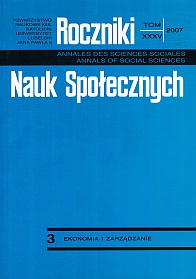Od wydajności do lojalności − relacje między firmą a jej zagranicznymi pracownikami − studium przypadku
Abstrakt
The paper focuses on the problem of the relationship between a firm and its foreign staff in a multicultural milieu. There are two areas of interest here: workers' loyalty, quality and work output. Due to contemporary economic, social, and demographic phenomena the enterprises of today more and more often work in varied milieus, and often deal with culturally different workforce. Accordingly, we have to look closer at the foreign staff of the firm. Its characterisation, needs, values or mentality affect the whole of the relations inside the firm. They decide about the quality and work output, allow to assess the degree of confidence in the organisation, or to measure the level of identification with the enterprise. The loyalty of foreigner in a firm is especially important here, the problems of fluctuation, absence, and lack of engagement. In the context of unifying Europe such an analysis allows to highlight the chances and threats that may appear when the labour markets are open for foreigners. One of the most important challenge that enterprises have to face will be to formulate positive relations among workers and a proper understanding of cultural factors in management.
Bibliografia
Bojarczuk B.: Niepokorna lojalność, „Personel i Zarządzanie” 2002, nr 11.
Eberhardt K.: Wydajność pracy – magiczne pojęcie? „Nowe Życie Gospodarcze” 2001, nr19.
Korporowicz L.: O międzykulturowych modelach zarządzania. Relacje między polskimi i zagranicznymi pracownikami firm, w: Kapitał zagraniczny w prywatyzacji, red. M. Jarosz, Warszawa: ISP PAN 1996.
Kowalski M.: Wierność (nie)odwzajemniona, „Personel i Zarządzanie” 2002, nr14.
Puch P.: Polak potrafi pracować, „Newsweek” 2003, nr 14.
Stonehouse G., Hamill J., Campbell D., Purdie T.: Globalizacja, strategia i zarządzanie, Warszawa: Felberg 2001, s. 168.
Copyright (c) 2007 Roczniki Nauk Społecznych

Utwór dostępny jest na licencji Creative Commons Uznanie autorstwa – Użycie niekomercyjne – Bez utworów zależnych 4.0 Międzynarodowe.


